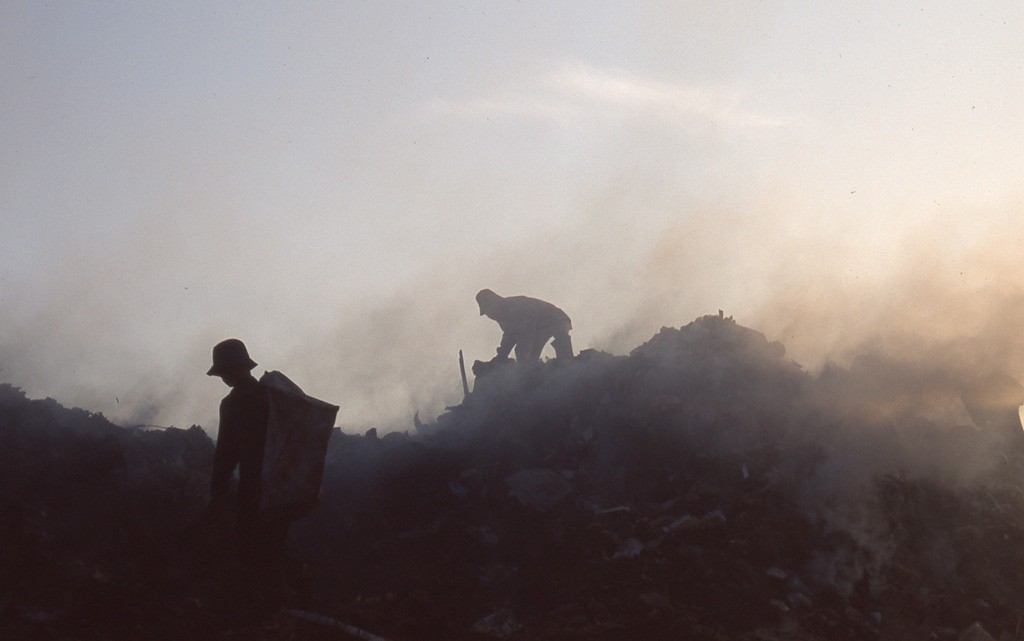
ផ្សែង និងក្លិនស្អុយ ហោះហើរក្នុងខ្យល់ នៅកន្លែងចាក់សំរាមដ៏ធំមួយក្នុងរាជធានីភ្នំពេញ។ ថត ដោយអេឡែន ម៉រហ្គែន, ១៧ កញ្ញា ២០១១។ ក្រោមអាជ្ញាប័ណ្ណ CC BY-NC-ND 2.0
ការបំពុលខ្យល់មានប្រភពចេញពីការដុតឥន្ធនៈ តួយ៉ាងប្រេងឥន្ធនៈ ប្រេងម៉ាស៊ូត និងធ្យូងសម្រាប់ការដឹកជញ្ជូន ការប្រើប្រាស់តាមផ្ទះ និងការប្រើប្រាស់ក្នុងវិស័យឧស្សាហកម្ម និងថាមពល។ ការដុតឥន្ធនៈទាំងនេះបានបញ្ចេញផ្សែងពុលចូលទៅក្នុងបរិយាកាសដែលបង្កឱ្យមានផលប៉ះពាល់គួរឱ្យកត់សម្គាល់ទៅលើគុណភាពខ្យល់ និងសុខភាពរបស់មនុស្ស។
ទោះបីជាប្រទេសកម្ពុជាមិនមែនជាប្រទេសដែលមានឧស្សាហកម្មជឿនលឿនខ្លាំងក៏ដោយ កម្ពុជាស្ថិតក្នុងលំដាប់ទី១៦៤ ក្នុងចំណោម ១៨០ប្រទេស នៅក្នុងសន្ទស្សន៍នៃការអនុវត្តខាងបរិស្ថាន (EPI) សម្រាប់គុណភាពខ្យល់ ក្នុងឆ្នាំ២០១៨។1 សន្ទស្សន៍EPI សម្រាប់ការវាស់ស្ទង់គុណភាពខ្យល់ ដែលត្រូវបានបង្កើតឡើងដោយ សាកលវិទ្យាល័យ Yale (វិទ្យាស្ថាន Yale សម្រាប់គោលនយោបាយ និងច្បាប់បរិស្ថាន) និង សាកលវិទ្យាល័យ Columbia ((វិទ្យាស្ថានសម្រាប់បណ្ដាញនៃព័ត៌មានវិទ្យាសាស្ត្រផែនដីអន្តរជាតិ) ក្នុងកិច្ចសហប្រតិបត្តិការជាមួយ វេទិកាសេដ្ឋកិច្ចពិភពលោក បានរួមបញ្ចូលនូវសូចនាករចំនួន ៣៖
- ការបំពុលខ្យល់ នៅកម្រិតប៉ះពាល់ជាមធ្យមស្មើ PM2.5 (ភាគល្អិតនិចល)
- ការបំពុលខ្យល់ នៅកម្រិតលើសពី PM2.5
- គុណភាពខ្យល់នៅតាមគេហដ្ឋាន។2
PM2.5 គឺជាភាគល្អិតនិចលតូចៗនៅក្នុងខ្យល់ ដែលមានអង្កត់ផ្ចិតតូចជាង ២,៥ មីក្រុង ឬប្រហែល ៣ ភាគរយនៃអង្កត់ផ្ចិតរបស់សក់មួយសរសៃ។ ភាគល្អិតទាំងនេះមានគ្រោះថ្នាក់ណាស់ ដែលអាចបង្កឱ្យមានការស្លាប់មុនអាយុពីជម្ងឺបេះដូង និងសួត ហើយភាគល្អិតនេះក៏អាចបង្កឱ្យកើតជម្ងឺហឺត រលាកទងសួត និងជម្ងឺដែលពាក់ព័ន្ធនឹងផ្លូវដង្ហើមផ្សេងៗទៀត។
អង្គការសុខភាពពិភពលោកបានកំណត់ការណែនាំគុណភាពខ្យល់សម្រាប់កម្រិត PM2.5 ជាមធ្យមប្រចាំឆ្នាំ ត្រឹម ១០ μg/m3។ ការបំពុលខ្យល់នៅកម្ពុជា មានកម្រិតខ្ពស់ជាង គឺ ២៦ μg/m3 ក្នុងឆ្នាំ ២០១៦។3 តួលេខរបស់ប្រទេសកម្ពុជាមានភាពល្អប្រសើរជាងមធ្យមភាគសកល ទោះបីជាយ៉ាងណាក៏ដោយក៏មាន ៥១ μg/m3។4
ក្រសួងបរិស្ថាន ជាអាជ្ញាធរទទួលបន្ទុកតាមឃ្លាំមើលគុណភាពខ្យល់ និងដោះស្រាយបញ្ហាបំពុលនៅប្រទេសកម្ពុជា។ ដោយត្រូវបានបង្កើតឡើងនៅឆ្នាំ២០០០ អនុក្រឹត្យស្តីអំពីការគ្រប់គ្រងការបំពុលខ្យល់ និងការរំខានដោយសម្លេង បានដាក់ចេញនូវស្តង់ដារសម្រាប់គុណភាពខ្យល់ក្នុងបរិយាកាសយ៉ាងជាក់លាក់។5 យោងទៅតាមច្បាប់ ប្រភពនៃការបំពុលខ្យល់ ត្រូវបានចែកជាប្រភពចល័ត (មានទីតាំងមិនអចិន្ត្រៃយ៍ ដូចជារថយន្ត) និងប្រភពអចល័ត (មានទីតាំងអចិន្ត្រៃយ៍ ដូចជារោងចក្រ)។6
និន្នាការថ្មី
វិស័យដឹកជញ្ជូន ផ្តល់ផលប៉ះពាល់ខ្លាំងទៅលើគុណភាពខ្យល់ ដោយសារកំណើននៃយានយន្ត និងការប្រើប្រាស់ប្រេងឥន្ធនៈ។ នៅក្នុងឆ្នាំ២០១៦ មានយានយន្ត ជាង ៣,២ លានគ្រឿងបានចុះបញ្ជី រួមបញ្ចូល ម៉ូតូចំនួន ២,៧ លានគ្រឿង ដែលការកើនឡើងនេះស្មើនឹង ១៤ភាគរយ បើធៀបនឹងឆ្នាំមុន។ស៊ន សារ៉ាត់ ឆ្នាំ២០១៦។ “រថយន្ត និងម៉ូតូជាង ៣,២ លានគ្រឿង បានចុះបញ្ជី”, កាសែតភ្នំពេញបុស្ដិ៍, ៨ មីនា ឆ្នាំ២០១៦។ http://www.phnompenhpost.com/business/32m-cars-motorbikes-registered ចូលអាន ២៣ កក្កដា ឆ្នាំ២០១៧។[/ref] ការដឹកជញ្ជូនកាន់តែច្រើនមានន័យថា ប្រេងឥន្ធនៈកាន់តែច្រើនត្រូវបានប្រើប្រាស់ ហើយសារធាតុពុលកាន់តែច្រើនត្រូវបានបញ្ចេញទៅក្នុងបរិយាកាស។
រឺម៉កកង់បី និងរថយន្តដឹកអ្នកដំណើររាប់រយគ្រឿង ដែលកំពុងបន្តប្រតិបត្តិការនៅជុំវិញតំបន់ប្រាសាទអង្គរវត្ត បង្កជាការគម្រាមកំហែងដល់គុណភាពខ្យល់នៅទីនោះ។ ក្នុងឆ្នាំ២០១៤ សារព័ត៌មាន Global Post បានរាយកាណ៍ថា គុណភាពខ្យល់នៅប្រាសាទអង្គរវត្ត ដែលជាតំបន់បេតិកភ័ណ្ឌពិភពលោកទទួលស្គាល់ដោយអង្គការ យូណេស្កូ បានក្លាយជាបញ្ហាគួរឱ្យព្រួយបារម្ភ។ ប្រាសាទអាចប្រឈមនឹងការខូតខាត ដែលបណ្តាលមកពីភ្លៀងអាស៊ីត។ សារព័ត៌មានដដែលបានឱ្យដឹងថា នៅមួយទសវត្សរ៍មុន ការបំពុលខ្យល់នៅខេត្តសៀមរាប មានសភាពយ៉ាប់យឺនខ្លាំងជាងនៅទីក្រុងបាងកក ដែលជារាជធានីមានប្រជាជនរស់នៅជាង ៨លាននាក់។7
កាលពីឆ្នាំ២០១៤ កាសែតភ្នំពេញប៉ុស្តិ៍បានរាយការណ៍ថា បណ្តាញដឹកជញ្ជូនក្នុងខេត្តសៀមរាបនឹងមានភាពល្អប្រសើរឡើងក្នុងការឆ្លើយតបទៅនឹងបញ្ហាបរិស្ថាន ដោយដាក់ឱ្យដំណើរការ រថយន្តដឹកអ្នកដំណើរដើរដោយថាមពលព្រះអាទិត្យ ចំនួន ៥០គ្រឿង។ រថយន្តថ្មីទាំងនេះ មានតម្លៃ ២៣០០០ ដុលា្លរក្នុងមួយគ្រឿង។8 កិច្ចផ្តួចផ្តើមថ្មីនេះត្រូវបានគេរំពឹងថា នឹងដោះស្រាយបញ្ហាបំពុលខ្យល់ និងភ្លៀងអាស៊ីត។ យ៉ាងណាមិញ មកដល់ត្រឹមពាក់កណ្តាលឆ្នាំ២០១៥ រថយន្តទាំងនេះពុំទាន់ត្រូវបានដាក់ឱ្យប្រើប្រាស់សាកល្បងនៅឡើយទេ។9
បានធ្វើបច្ចុប្បន្នភាពចុងក្រោយ៖ ៧ ឧសភា ២០១៩
ទាក់ទងនឹងការបំពុលខ្យល់
ឯកសារយោង
- 1. សន្ទស្សន៍នៃការអនុវត្តខាងបរិស្ថាន។ កម្ពុជា៖ គុណភាពខ្យល់ ឆ្នាំ២០១៨។ ចូលអាន ៧ ឧសភា ២០១៩។ http://epi.yale.edu/country/cambodia
- 2. ដូចឯកសារយោងខាងលើ។
- 3. វិទ្យាស្ថានផលប៉ះពាល់សុខភាព។ ឆ្នាំ២០១៨។ ស្ថានភាពនៃគុណភាពខ្យល់សកល ឆ្នាំ២០១៨។ របាយការណ៍ពិសេស។ បូស្ដុន, រដ្ឋម៉ាសាឈូសេត៖ វិទ្យាស្ថានផលប៉ះពាល់សុខភាព។ https://www.stateofglobalair.org/report ចូលអាន ៣០ មេសា ២០១៨។
- 4. ដូចឯកសារយោងខាងលើ។
- 5. អនុក្រឹត្យស្តីពីការគ្រប់គ្រងការបំពុលដោយខ្យល់និងការរំខានដោយសម្លេង។ ឆ្នាំ២០០០។
- 6. ដូចឯកសារយោងខាងលើ។
- 7. Denise Hruby. “នៅកម្ពុជា ខ្យល់មានជាតិពុលគម្រាមកំហែងដល់ប្រាសាទទ្រុឌទ្រោមមិនចេះចប់”។ សារព័ត៌មាន Global Post, ៧ កក្កដា ២០១៤។ ចូលអាន ១៦ កុម្ភៈ ២០១៦។http://www.globalpost.com/dispatch/news/regions/asia-pacific/cambodia/140630/cambodia-toxic-air-threatens-timeless-ruins.
- 8. De Carteret, Daniel. “រថយន្តប្រើថាមពលពន្លឺព្រះអាទិត្យនឹងធ្វើប្រតិបត្តិការនៅតំបន់ ប្រាសាទអង្គរ។” កាសែតភ្នំពេញប៉ុស្តិ៍, ០៦ កញ្ញា ២០១៤។ ចូលអាន ១៥ កុម្ភៈ ២០១៦។ http://www.phnompenhpost.com/post-weekend/solar-buses-temples-angkor.
- 9. Ayanna Runcie, ឆ្នាំ២០១៥។ “ហាងលក់ផលិតផលប្រើប្រាស់ថាមពលពន្លឺព្រះអាទិត្យ គ្រប់មុខ។” គេហទំព័រ Thailandchatter.com, ២៩ សីហា ២០១៥។ ចូលអាន ២៨ កុម្ភៈ ២០១៦។ http://thailandchatter.com/showthread.php?6448-Cambodia-Star8-One-stop-solar-shop.

